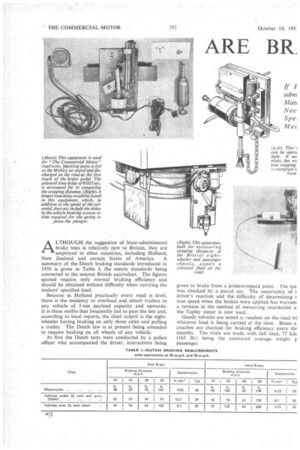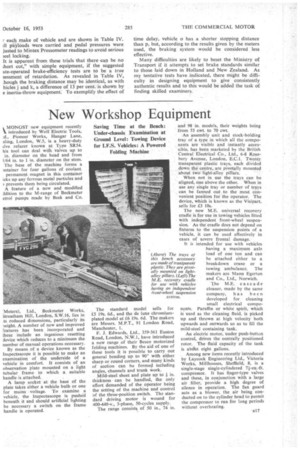ARE BR ,TANDARDS TICABLE ?
Page 46

Page 47

Page 48

Page 51

If you've noticed an error in this article please click here to report it so we can fix it.
By Laurence J. Cotton,
M.I.R.T.E.
ALTHOUGH the suggestion of State-administered . brake tests is relatively new to Britain, they are employed in other countries, including Holland, New Zealand and certain States of America. A summary of the Dutch braking standards introduced in
1950 is given in Table I, the metric standards being converted to the nearest British equivalent. The figures quoted require only normal braking efficiency and should be obtained without 'difficulty when carrying the makers' specified load.
Because in Holland practically every road is level, there is the tendency to overload and attach trailers to any vehicle of 5-ton payload capacity and upwards.
It is these outfits that frequently fail to pass the test and, according to local reports, the chief culprit is the eight wheeler having braking on only three axles and pulling a trailer. The Dutch law is at present being amended to require braking on all wheels of any vehicle.
At first the Dutch tests were conducted by a police officer who accompanied the driver, instructions being given to brake from a predetermined point. The Spe was checked by a patrol car. The uncertainty of t driver's reaction and the difficulty of determining t true speed when the brakes were applied has warrant a revision in the method of measuring retardation al the Tapley meter is now used.
Goods vehicles are tested at random on the road wi whatever load is being carried at the time. Buses al coaches are checked for braking efficiency every thr months. The trials are made with full load, 75 kilt (165 lb.) being the estimated average weight p passenger.
In New Zealand all motor vehicles are inspected for ;eneral mechanical fitness at six-monthly intervals, the Drakes being tested at municipally owned stations or 3y Transport Commission inspectors on the road. Prac:ically every large town has a municipal testing centre 3r approved garage at which car brakes are tried on a Weaver machine. Commercial vehicles are tried on the ~oad, brake efficiency being measured with .a Tapley meter. The standard required is shown in Table H.
There are lessons to be learned from the Dutch and New Zealand regulations. Differences in braking effiziency of a vehicle selected at random on the road, as compared with that of one specially prepared for examination at specified intervals, are noteworthy. Although, by careful maintenance and adjustment, it might be possible to maintain the high brake efficiency of a new vehicle, there might be marked depreciation after 1,000-2,000 miles' hard driving without attention. The standards for a random test have, therefore, to be adjusted accordingly.
The New Zealand and Dutch standards seem to be closely allied, apart from the requirement in hand-brake efficiency of a laden passenger vehicle in Holland. A Tapley reading of 25 per cent. with full load is a remarkably high standard without power assistance.
There is often a marked difference between the physically measured braking distance and the result obtained with a pendulum or inertia-throw instrument. The reasons are explained later.
There are three instruments of the pendulum or inertia-throw type made in Britain. One of these would probably be used for brake tests on the road by the Ministry of Transport examiners or police if a specific standard of brake efficiency were laid down by law.
The Mintex Halo test meter measures the maximum deceleration of a vehicle and costs £3 3s. It comprises a hermetically sealed cell part-filled with liquid which is transferred from one limb to the other during braking, one side being graduated in terms of per cent. g. The theoretical acceleration caused by gravity, 32 ft. per sec. per sec., is taken as 100 per cent.
In use, the Mintex device is attached to the windscreen or facia panel by suction cups and is set to zero on level ground before starting the trial. An observer is required to note the reading because the liquid returns to its former level fairly rapidly.
Like the Halo device the Tapley brake meter, costing £1.5 15s., does not depend for its efficient working on the speed of the vehicle. It is known to be employed by Ministry of Transport certifying officers when checking the hand-brake efficiency of passenger vehicles.
It works on the pendulum principle and has a permanent magnet suspended. in a non-magnetic casing which is almost completely filled with a light damping fluid. The lower end of the magnet, acting in. pendulum fashion, is separated from a co-axially mounted armature by a brass diaphragm, the armature being geared to a dial which is read through a window of the casing. The damping,system compensates for changes in temperature and a ratchet holds the scale at the maximum reading until reset.
The main criticism applicable to inertia-throw equipment is that it gives no indication of delays in the braking system, and weight transference from the rear to the front axle may affect the result if the deceleration is high.
Another Tapley product is the tilting-tube maximumbraking indicator, comprising three tubes set at predetermined angles and each containing a steel ball. When a certain rate of deceleration is reached the ball rolls along the casing, according to the angle of each tube, and causes the tube to pivot and bring up a coloured marker. The tubes are set to show deceleration of 0.3, 0.5 and 0.6 g., but different values could, if necessary, be indicated.
Simple Equipment The tipping-tube meter is effective and, assuming that brake standards are based on Tapley readings, it would be the simplest equipment for the average driver or mechanic to use. It costs 1 10s. complete.
In addition to the proprietary instruments, I have seen and used many home-made brake-testing devices. Most of them have the drawback of depending on accurate speed recording for correct results, whereas, speedometers are often inaccurate.
The Construction and Use Regulations specify that a speedometer should be accurate within plus or minus 10 per cent. at 20 m.p.h. or 30 m.p.h., according to the type of vehicle. To illustrate how such an error would affect measured brake stopping distances, I have compiled Table III, using the Dutch standards as a basis and converting the equivalent stopping distances that would be obtained. It will be seen -that the results of brake tests, based on readings taken from an unchecked speedometer might be most inaccurate.
The simplest method of checking a speedometer is to time the vehicle, travelling at a steady speed between two points of known distance apart. I find that 440 yd. is a reasonable distance over which to drive a vehicle at a steady 20 m.p.h. or 30 m.p.h. for checking purposes. It is preferable to make several runs.
With an accurate speedometer fitted I would prefer to use the home-made devices to find the stopping distances of heavier vehicles, especially of articulate( units or tractors pulling trailers, in which there may 13( a relatively long delay before full line pressure reache: the brake shoes.
Vehicle manufacturers and some of the larger opera tors have developed equipment for measuring stopping distance and employ a fifth wheel to record speec accurately. Provided that the brake test apparatus i! operated directly from the brake pedal in vehicles having vacuum or air-pressure braking, the measured stopping distance will be reasonably accurate. If the attachmeni were operated by the stop-light or by a brake camshaft at the wheel, the stopping distance would not be accurate because it would not include the time delay in building up pressure in the braking system.
I have checked locally built apparatus against the solenoid-operated Webley pistol and magazine. In the latter a chalk pellet is discharged on the ground instantaneously when 2 lb. pedal pressure is applied. My investigations have Shown that where home-made devices may be within 2-3 ft. accurate from 30 m.p.h. when actuated by the brake pedal, the error might be increased to 36 ft. if the apparatus were operated from the stop light or brake shoe of an articulated vehicle.
Time Delay In general, over a limited number of vehicle tests, the results have indicated that the straightforward hydraulic brake systed is practically instantaneous in application and that vacuum-assisted hydraulic brake gear has a time delay of about 0.1 sec., corresponding to 4-5 ft. on measured stopping distance at 30 m.p.h.
The vacuum-assisted mechanical brake varies in time delay from 0.2 to 0.33 sec., equal to 8-14 ft. stopping distance at 30 m.p.h. Compressed-air-operated brakes show a time delay of 0.125 sec. to 0.4 sec. between the application of pressure to the pedal and the initial movement of the brake camshaft. These delays equal 61-174 ft. from 30 m.p.h.
These trials were conducted on new vehicles with the brakes in good condition. Few tests have been made on articulated units, but there appears to be a longer time delay. Up to 0.8 sec. was noted on one outfit.
In an endeavour to obtain comparative results, the trials have been conducted with additional readings supplied by proprietary inertia-throw meters. From these. tests there appears to be no definite constant, because there is a wide variation in the time required to build up pressure in vehicles of different makes but using similar brake gear, and the degree of weight transference (brake dive) introduces a further variable.
No significant conclusions can be drawn, but, as an indication of the trend, average results have been taken
r each make of vehicle and are shown in Table IV. ill payloads were carried and pedal pressures were justed to Mintex Pressometer readings to avoid serious ice! locking.
It is apparent from these trials That there can be no ;lion cut," with simple equipment, if the suggested ate-operated brake-efficiency tests are to be a true sessment of retardation. As revealed in Table IV, hough the braking distance may be identical, as with hides j and k, a difference of 13 per cent. is shown by e inertia-throw equipment. To exemplify the effect of time delay, vehicle o has a shorter stopping distance than p, but, according to the results given by the meters used, the braking system would be considered less effective.
Many difficulties are likely to beset the Ministry of Transport if it attempts to set brake standards similar to those laid down in Holland and New Zealand. As my tentative tests have indicated, there might be difficulty in designing equipment to give consistently authentic results and to this would be added the task of finding skilled examiners.




























































































